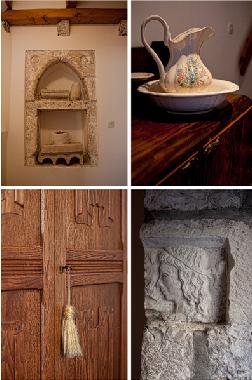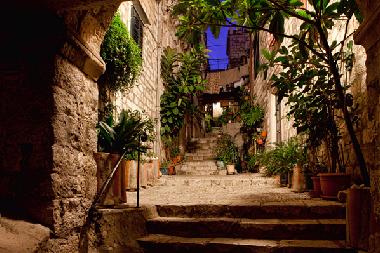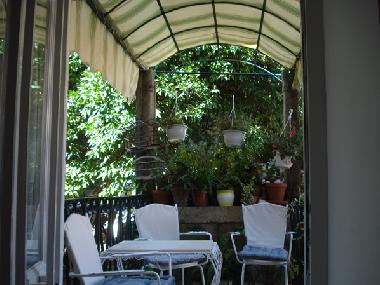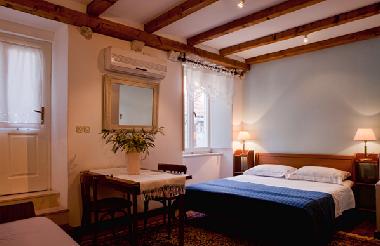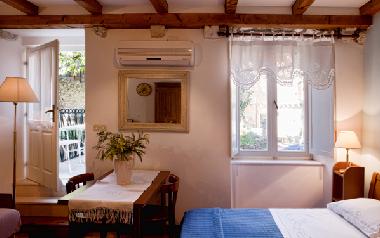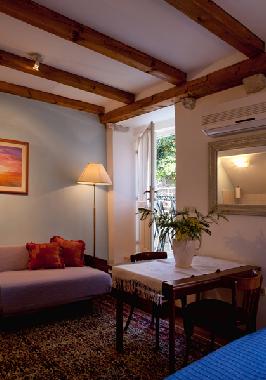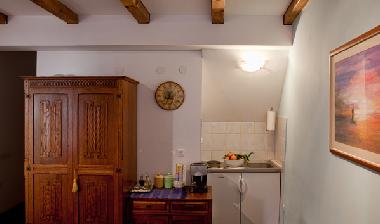








CURRENT OBJECT: DUBROVNIK ANGEL'S HOUSE OLD TOWN-MOSKAR APT. WITH BALCONY
| Next vacation rental in Dubrovacko-Neretvanska | |
| Next vacation rental in Croatia |
Current region: Europe > Croatia > Dubrovacko-Neretvanska > Dubrovnik | Add to your favorite list Your favoritelist |
“Angel\'s\" is a centuries-old house, located on a quaint, quiet street within the city walls
| More pictures... | ||||||
Rental Price60 Euro per object per dayPrice includes following expenses
Description of objectMoskar apartment has 30m2, is intended for 2 + 1 persons located on first floor with balcony, and consist of1 bed room with double bed, sofa bed and kitchen corner, bathroom, air-condition, SAT TV. The house has been lovingly renovated and the result is a combination of modern & rustic, retaining many charming features such as the stone details in the kitchen and original exposed wooden beams which is typical in Dalmatian houses. “Angel\'s House\" suits a small group of friends or a small family looking to enjoy their stay in a cosy and charming place. Wireless internet connection. Pets not allowed. Quiet location. Location of object“Angel\'s\" is a centuries-old house, located on a quaint, quiet street within the city walls and overlooking the Old Town from the balcony.Less than 100 meters from the house a small gateway through the city wall will lead you down to the crystal clear sea and to the open air bar, Buza II, with the most beautiful view the city has to offer. A few steps further down a bathing area invites you to refresh yourself in the cool water, to go swimming or snorkelling. Paid parking on street available or at nearby garage. Airport transfer service. There are few stairs to arrive to Angel\\\'s House so it suitable for old people but not people with disabilities or in wheelchair. Town: Croatia, Dubrovnik, DubrovnikPast History of DubrovnikThe words «Non bene pro toto libertas venditur auro» - «Freedom is not to be sold, not for all the gold of the world» were inscribed long ago during the times of the Dubrovnik Republic above the gates on Fort Lawrence, an impenetrable fortress. Throughout its turbulent history, many sovereign and maritime powers came into conflict in this region: Byzantine, Saracen, Croat, Norman, Venetian, small principalities and kingdoms, even the Hungarian-Croat state, followed by the Roman-German empire, and the Ottoman, Habsburg and Napoleon empires. On such a boundary line, the small city of Dubrovnik succeeded in achieving a completely independent form of self-government based on political ingenuity, so that the Dubrovnik Republic remained a neutral, independent state for centuries. The successful development of Dubrovnik in the past was conditioned primarily by its favorable geographical position, and by an economy based on maritime and merchant activities. When entering the Adriatic Sea, Dubrovnik is the first island-protected port on the maritime route going from east to west, with quick access to the hinterland by way of the Neretva Valley. Latest archaeological research has shown that a settlement dating to the 6th century or probably even earlier existed under today’s city. It expanded with the arrival of the Croats in the 7th century, following the abandonment of ancient Epidaurus (today’s Cavtat). The intensification of traffic between the East and West both during and after the Crusades resulted in the development of maritime and mercantile centers throughout the Mediterranean and the Adriatic Sea in the 12th and 13th centuries. Dubrovnik was one of them. The Zadar Treaty in 1358 liberated Dubrovnik from Venetian rule, and it was crucial to the successful furthering of its development. The remaining Dalmatian towns failed to achieve this, so that they definitely fell under Venetian rule in the year 1420. Already during the 14th and 15th centuries, Dubrovnik was the most significant maritime and mercantile center of the Adriatic, alongside Venice and Ancona. Dubrovnik expanded its territory by using contracts and by purchasing land from Klek in the north to Sutorina at the entrance to the Bay of Kotor, including the islands of Mljet, Lastovo, Elaphite and Lokrum. The legal status of the Dubrovnik Republic was completely achieved by the 15th century. This meant the independent election of a rector and councilors, the minting of currency, a state flag with an image of St. Blaise, independent legislature, and the right to establish consulates abroad. According to the aristocratic constitution, the state authority was based on the Great Council, which was made up of Dubrovnik aristocratic families. They, in turn, appointed the members of the Senate and the Small Council, which was the executive body of the Great Council. The Rector was appointed on a monthly basis as a nominal symbol of authority. Already in the 15th century, Dubrovnik had a well-organized transit trade route with the Balkan hinterland. In 1525, due to the stronger Turkish expansionist policies in the Balkans, the Dubrovnik Republic decided to accept Turkish tutelage and the payment of tribute. However, in return, they obtained the right to free trade throughout the Turkish Empire, with a custom’s duty of only 2%. This small state, which had no army of its own, brought its defensive mechanism to perfection using skilful diplomacy and broad consular activities. It managed to preserve its independency by maintaining neutrality in international conflicts, and by using the tutelage of powerful countries, especially that of Spain and the Vatican. The Venetian Republic was its only permanent rival and enemy. The Dubrovnik Republic entered its golden age in the 16th century, at a time when the power and glory of the Venetian Empire was on the wane. Its prosperity was based on maritime trade. In the 16th century, the Dubrovnik merchant navy matched world levels with its quality fleet of 180 to 200 ships. Increasingly larger types of ships were being built, such as galleys, coasters and navas. These ships were taking on increasingly longer and more dangerous journeys throughout the Mediterranean and Black Sea, as well as ocean journeys to northern ports in England and Germany, even as far as India and the Americas. Dubrovnik became world-renowned and sought after for the transport of cargo, which included very diverse maritime and trade affairs. Material prosperity, and the feeling of security and freedom, helped shape a humanist culture that further inspired ardent creativity. Dubrovnik reached magnificent levels of achievement in its urban and architectural development that has been maintained to the present day, in its literature and poetry (Marin Dr¸ić, Ivan Gundulić), sciences (Ruđer Bo¨ković), and in many other fields of art and culture. In the 17th century, the general crisis in Mediterranean maritime affairs also affected Dubrovnik maritime trade. The catastrophic earthquake of 1667 brought the Dubrovnik Republic into a critical period, where it fought for its survival and political independence. The 18th century gave Dubrovnik an opportunity for the economic revival of maritime trade under a neutral flag. This was the state of affairs when Napoleon dissolved the Dubrovnik Republic in 1808. At the Vienna Congress in 1815, the Dubrovnik region was joined to the other parts of Dalmatia and Croatia. Since then, they have shared a common political fate. Following the Republic of Croatia’s declaration of independence and subsequent Serbian aggression on Croatian territory, Dubrovnik was attacked in October of 1991. The Serbians and the Montenegrins aimed to conquer and destroy the region, attacking with a destructive force that had never been seen so far. The Dubrovnik region was occupied and significantly devastated. In the 8-month siege, the city itself was repeatedly bombarded. The most brutal destruction occurred on December 06th, 1991. Today, the war-devastated cultural heritage of Dubrovnik has been repaired for the most part. The renovated hotels, the important assets of the Dubrovnik Summer Festival, as well as other cultural events are crucial prerequisites for the development of modern tourism. UNESCO HERITAGE The walls of Dubrovnik girdle a perfectly preserved complex of public and private, sacral and secular buildings representing all periods of the City\\\'s history, beginning with its founding in the 7th century. Since 1979 Dubrovnik is in the register of UNESCO as a protected World heritage. Particular mention should be made of the city\\\'s main street in the old historical center - Stradun, Rector\\\'s Palace, St. Blaise’s Church, Cathedral, three large monasteries, tCustom\\\'s Office and the City Hall. The Republic of Dubrovnik was the centre of a separate political and territorial entity, and was proud of its culture, its achievements in commerce and especially of its freedom, preserved in the course of the stormy centuries. Find out more about Dubrovnik Arrival and distancesArrival day: anyDistance to next airport: Cilipi 20 Km Distance to next trainstation: Ploce 100 Km Distance to the sea: Adriatic 1 Km Distance to next shop: 0.1 Km Sport facilities nearbyDiving, Fishing, Sailing, Swimming, Water ski,Theme of holidays
Total sleeping facilities and distributionTotal number of sleeping facilities: 1
BathroomsNo. of bathrooms: 1
External facilities of object
Internal facilities of object
Machines and equipment
Kitchen facilities
Services
Other
CateringCatering: Self catered (extra) |
| ||||||||||||||||||||||||||||||||||||||||||||||||||||||||||||||||||||||||||||||||||||||||||||||||||||||||||||||||||||||||||||||||||||||||||||||||||||||||||||||||||||||||||||||||||||||||||||||||||||||||||||||||||||||||||||||||||||||||||||||||||||||||||||||||||||||||||||||||||||||||||||||||||||||||||||||||||||||||||||||||||||||||||||||||||||||||||||||||||||||||||||||||||||||||||||||||||||||||||||||||||||||||||||||||||||||||||||||||||||||||||||||||||||||||||||||||||||||||||||||||||||||||||||||||||||||||||||||||||||||||||||||||||||||||||||||||||||||||||||||||||||||||||||||||||||||||||||||||||||||||||||||||||||||||||||||||||||||||||||||||||||||||||||||||||||||||||||||||||||||||||||||||||||||||||||||||||||||||||||||||||||||||||||||||||||||||||||||||||||||||||||||||||||||||||||||||||||||||||||||||||||||||||||||||||||||||||||||||||||||||||||||||||||||||||||||||||||||||||||||||||||||||||||||||||||||||||||||||||||||||||||||||||||||||||||||||||||||||||||||||||||||||||||||||||||||||||||||||||||||
| |||||||||||||||||||||||||||||||||||||||||||||||||||||||||||||||||||||||||||||||||||||||||||||||||||||||||||||||||||||||||||||||||||||||||||||||||||||||||||||||||||||||||||||||||||||||||||||||||||||||||||||||||||||||||||||||||||||||||||||||||||||||||||||||||||||||||||||||||||||||||||||||||||||||||||||||||||||||||||||||||||||||||||||||||||||||||||||||||||||||||||||||||||||||||||||||||||||||||||||||||||||||||||||||||||||||||||||||||||||||||||||||||||||||||||||||||||||||||||||||||||||||||||||||||||||||||||||||||||||||||||||||||||||||||||||||||||||||||||||||||||||||||||||||||||||||||||||||||||||||||||||||||||||||||||||||||||||||||||||||||||||||||||||||||||||||||||||||||||||||||||||||||||||||||||||||||||||||||||||||||||||||||||||||||||||||||||||||||||||||||||||||||||||||||||||||||||||||||||||||||||||||||||||||||||||||||||||||||||||||||||||||||||||||||||||||||||||||||||||||||||||||||||||||||||||||||||||||||||||||||||||||||||||||||||||||||||||||||||||||||||||||||||||||||||||||||||||||||||||||

